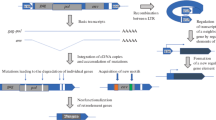Summary
A new method of analyzing phylogenetic relations among members of sequence family (Quentin 1988) discriminates at least six possible B1 subfamilies in the mouse genome. Several additional and independent observations suggest that these grouping have evolutionary significance, and that successive waves of fixation of new variants occur during rodent lineage history. We have reason to believe that, in a genome, the founder sequences of different families of retroposons are in competition with regard to the amplification/fixation process.
Similar content being viewed by others
References
Benzecri JP (1969) Statistical analysis as a tool to make patterns emerge from data. In: Watanabe S (ed) Methodologies of pattern recognition. Academic Press, New York, p 35
Bilofsky HS, Burks C, Fickett JW, Goad WB, Lewitter FI, Rindone WP, Swindell CD, Tang C-S (1986) The GenBank genetic sequence data bank. Nucleic Acids Res 14:1–14
Bird AP (1980) DNA methylation and the frequency of CpG in animal DNA. Nucleic Acids Res 8:1499–1504
Britten RJ, Baron WF, Stout DB, Davidson EH (1988) Sources and evolution of human Alu repeated sequences. Proc Natl Acad Sci USA 85:4770–4774
Goggins LW, Vass JK, Stinson MA, Lanyon WG, Paul J (1982) A B1 repetitive sequence near the mouse β-major globin gene. Gene 17:113–116
Daniels GR, Deininger PL (1985) Integration site preferences of the Alu family and similar repetitive DNA sequences. Nucleic Acids Res 13:8939–8954
Gouy M, Milleret F, Mugnier C, Jacobzone M, Gautier C (1984) ACNUC: a nucleic acid sequence data base and analysis system. Nucleic Acids Res 12:121–127
Gouy M, Gautier C, Milleret F (1985) System analysis and nucleic acid sequence banks. Biochimie 67:433–436
Haynes SR, Jelinek WR (1981) Low molecular weight RNAs transcribed in vitro by RNA polymerase III from Alu-type dispersed repeats in Chinese hamster DNA are also found in vivo. Proc Natl Acad Sci USA 78:6130–6134
Higgins DG, Gouy M (1987) Interfacing similarity search software with the sequence retrieval system ACNUC. CABIOS 3:239–241
Jurka J, Smith T (1988) A fundamental division in the Alu family of repeated sequences. Proc Natl Acad Sci USA 85:4775–4778
Kalb VF, Glasser S, King D, Lingrel JB (1983) A cluster of repetitive elements within a 700 base pair region in the mouse genome. Nucleic Acids Res 11:2177–2184
Koop BF, Miyamoto MM, Embury JE, Goodman M, Czelusniak J, Slightom JL (1986) Nucleotide sequences and evolution of the orangutan epsilon globin gene region and surrounding Alu repeats. J Mol Evol 24:94–102
Kramerov DA, Grigoryan AA, Ryskov P, Georgiev GP (1979) Long double-stranded sequences (ds RNA-B) of nuclear pre-mRNA consist of a few highly abundant classes of sequences: evidence from DNA cloning experiments. Nucleic Acids Res 6:697–713
Krayev AS, Kramerov DA, Skryabin KG, Ryskov AP, Bayev AA, Georgiev GP (1980) The nucleotide sequence of the ubiquitous repetitive DNA sequence B1 complementary to the most abundant class of fold-back RNA. Nucleic Acids Res 8:1201–1215
Krayev AS, Markusheva TV, Kramerov DA, Ryskov AP, Skryabin KG, Bayev AA, Georgiev GP (1982) Ubiquitous transposon-like repeats B1 and B2 of the mouse genome: B2 sequencing. Nucleic Acids Res 10:7461–7475
Mannella CA, Frank J, Delihas N (1987) Interrelatedness of 5S RNA sequences investigated by correspondence analysis. J Mol Evol 24:228–235
Quentin Y (1988) The Alu family developed through sucessive waves of fixation closely connected with primate lineage history. J Mol Evol 27:194–202
Rogers J (1985) The origin and evolution of retroposons. Int Rev Cytol 76:67–112
Sawada I, Willard C, Shen C-KJ, Chapman B, Wilson AC, Schmid CW (1985) Evolution of Alu family repeats since the divergence of human and chimpanzee. J Mol Evol 22:316–322
Schmid CW, Jelinek WR (1982) The Alu family of dispersed repetitive sequences. Science 216:1065–1070
Slagel V, Flemington E, Trina-Dorge V, Bradshaw H, Deininger P (1987) Clustering and subfamily relationships of the Alu family in the human genome. Mol Biol Evol 4:19–24
Smith TF, Waterman NS (1981) Identification of common molecular subsequences. J Mol Biol 147:195–197
Ullu E, Tschudi C (1984) Alu sequences are processed 7SL RNA genes. Nature 312:171–172
Ullu E, Weiner AM (1985) Upstream sequences modulate the internal promoter of the human 7SL RNA gene. Nature 318:371–374
Weiner AM, Deininger PL, Efstradiatis A (1986) Nonviral retroposons: genes, pseudogenes, and transposable elements generated by the reverse flow of genetic information. Annu Rev Biochem 55:631–661
Willard C, Nguyen HT, Schmid CW (1987) Existence of at least three distinct Alu subfamilies. J Mol Evol 26:180–186
Young PR, Scott RW, Hamer DH, Tilghman SM (1982) Construction and expression in vivo of an internally deleted mouse α-fetoproteine gene: presenceof a transcribed Alu-like repeat within the first intervening sequence. Nucleic Acids Res 10:3099–3116
Author information
Authors and Affiliations
Rights and permissions
About this article
Cite this article
Quentin, Y. Successive waves of fixation of B1 variants in rodent lineage history. J Mol Evol 28, 299–305 (1989). https://doi.org/10.1007/BF02103425
Received:
Revised:
Issue Date:
DOI: https://doi.org/10.1007/BF02103425




